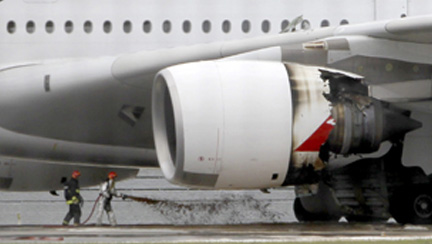

QANTAS has reserved its right to take legal action against Rolls-Royce under the Australian Trade Practices Act.
Investigators have traced last month’s A380 engine failure near Singapore to a badly manufactured oil tube.
The airline yesterday filed a statement of claim and was granted an injunction by the Federal Court it said would ensure that it could pursue legal action against Rolls-Royce “if a commercial settlement is not possible”.
While Qantas is still hoping for a negotiated deal, it said the action allowed it to keep all options open to recover losses as a result of the grounding of the A380 fleet.
Analysts have estimated this could be worth between $26 million and $60m – in addition to the $US70m ($72.4m) that one insurance company has predicted it will cost to fix the plane.
Qantas chief executive Alan Joyce was not putting a figure on the debacle yesterday, saying the damage was ongoing and uncertainty remained about when the remaining aircraft would get back in the air.
But he said there was cost in keeping six aircraft on the ground with their crews as well as a loss in revenue because of the 5 per cent cut in capacity and brand issues. The Qantas legal move comes as questions remain about what Rolls-Royce knew about problems in the engines, which have since been modified twice, but failed to tell the airlines.
It also coincided with an Australian Transport Safety Bureau safety alert issued after investigators determined an oil leak that led to a damaging fire inside the engine most likely stemmed from fatigue cracking in the thin side of an unevenly bored oil tube.
The fire caused superheating in the turbine disc area, which led to the disintegration of the intermediate pressure turbine disc and resulted in substantial damage to the plane. While investigators are yet to describe the cracked tube as the smoking gun, they say it is “a realistic possibility” that it caused the engine’s disintegration.
They were also sufficiently concerned about the safety implications and the possibility of another catastrophic failure to quickly issue the alert, which was immediately translated into an airworthiness directive by the Civil Aviation Safety Authority.
The fear is that there is batch of flawed oil tubes on the earliest “A-version” Trent 900 engines produced by Rolls-Royce and that an intermediate group B-version that received some modifications may also have them. The latest C engines to come off the production line are known not to be affected.
“The A-version is likely to have at least some of these problems,” ATSB chief commissioner Martin Dolan said. “The B-version probably doesn’t but we don’t have enough assurance that there isn’t; the C-version doesn’t have this problem.”
Qantas is no longer flying A-version engines and is concentrating its immediate efforts on the B engines on its two operating A380s. Mr Joyce said the tests took about an hour for each engine and the airline was using a three-dimensional borescope to check for the skewed oil pipes. He said it should have the results for the two aircraft overnight and would then proceed with testing of engines on the still-grounded planes.
“If we find a problem, that engine won’t fly,” he said.
Mr Joyce said Qantas would continue checks every 20 flights to look for signs of leaking oil and cracks. He said it would be unusual for a misaligned oil tube to be a one-off because manufacturing was machine-driven. He believed it was likely there was a batch of problem pipes.





